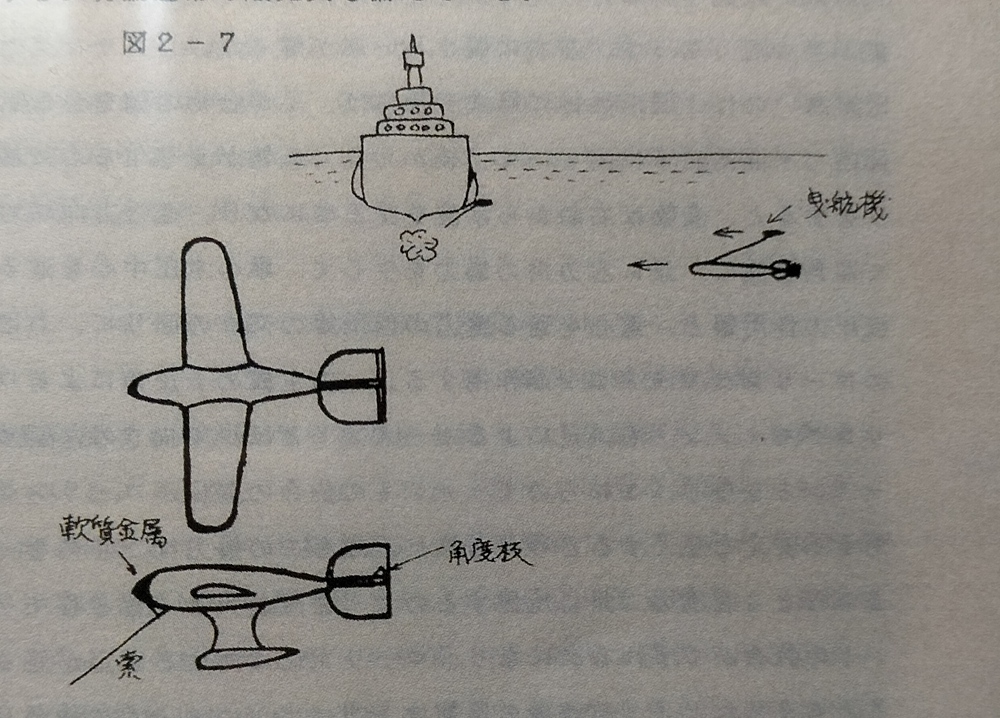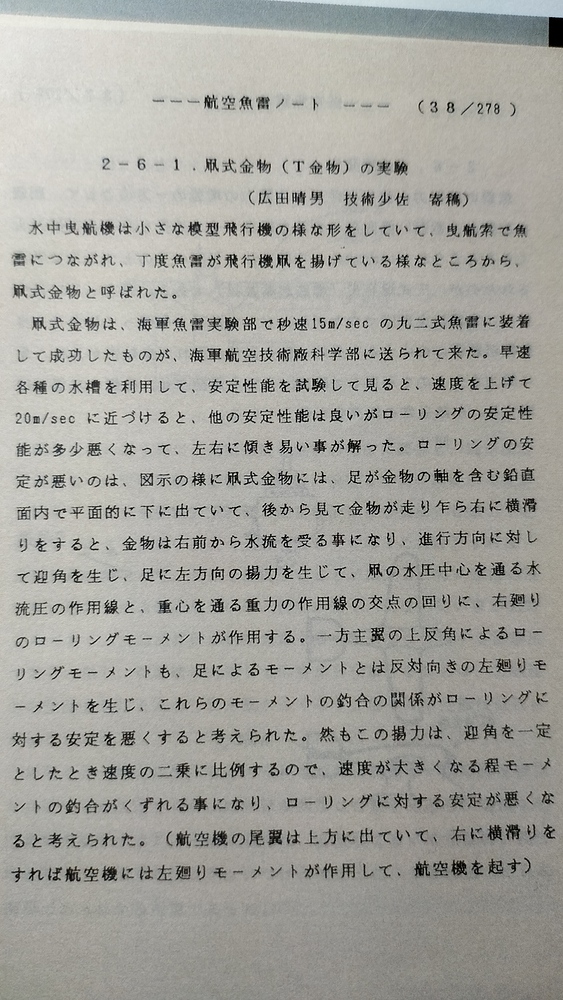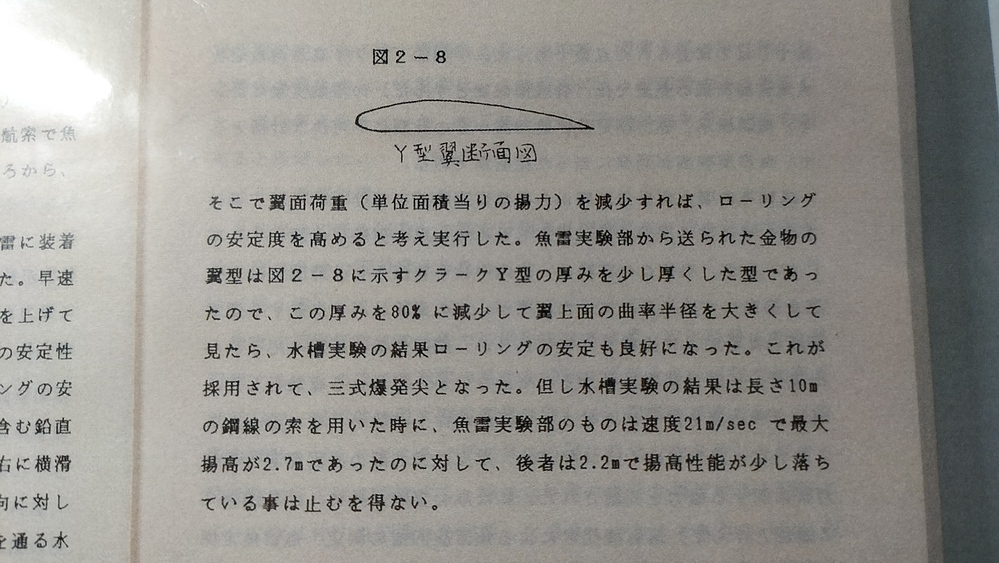- Yes
- No
!!Attention!! Before reading this article, please read the article about the Type 91 Torpedo Model 5 with Model 7 Warhead.link
Type 3 Explosive Point “三式爆発尖”
History
As the defensive capabilities of warships have become stronger, one method of increasing their offensive power has long been considered: to increase the effectiveness of torpedoes by detonating them at the bottom of the ship, where their defenses are weakest. The Type 3 Explosive Point (bottom detonator) was devised to make this attack method a reality. As shown in the diagram, the torpedo speeds along, pulling an underwater tow plane attached by a tow line. When the tow plane hits the side of the ship, the soft metal part at the tip is crushed, causing the tow line to come off, and taking advantage of the sudden loss of tension, the torpedo explodes at the bottom of the ship, destroying the bottom of the ship. Of course, it also has a normal exploding point.
Experimental Record
(Contributed by Technical Lieutenant Commander Haruo Hirota)
The underwater tow vehicle resembles a small model airplane and is tethered to the torpedo by a towline, resembling the torpedo flying a kite, hence the name “kite-type hardware.”
The kite-type hardware was successfully installed on a Type 92 torpedo, traveling at a speed of 15 m/s, by the Navy Torpedo Experimental Department and sent to the Naval Aviation Technical Arsenal’s Science Department. Stability testing was immediately conducted using various water tanks, and it was found that increasing the speed to approach 20 m/s improved stability in all other respects, but reduced rolling stability and made the torpedo prone to tilting to the left or right. The reason for the poor rolling stability is that, as shown in the figure, the kite-type metal frame has its feet extending flat downward in a vertical plane including the axis of the frame. When the frame skids to the right while moving as viewed from behind, the frame receives the water current from the front right, creating an angle of attack relative to the direction of travel, generating lift to the left. This creates a clockwise rolling moment around the intersection of the line of action of the water current pressure passing through the center of water pressure and the line of action of gravity passing through the center of gravity. Meanwhile, the rolling moment due to the dihedral angle of the main wing also creates a counterclockwise moment in the opposite direction to the moment caused by the feet. The imbalance of these moments is thought to worsen rolling stability. Furthermore, since this lift is proportional to the square of the speed when the angle of attack is constant, the greater the speed, the greater the imbalance of the moment, which is thought to worsen rolling stability. (The tail of an aircraft is pointing upward, and if it skids to the right, a counterclockwise moment acts on the aircraft, causing it to rise.)
Y-shaped wing cross section
We therefore considered reducing the wing loading (lift per unit area) to improve rolling stability. The metal wing provided by the Torpedo Experimental Department was a slightly thicker version of the Clark Y-shaped wing shown in Figure 2-8. By reducing this thickness to 80% and increasing the radius of curvature of the upper wing surface, tank experiments showed improved rolling stability. This was adopted, resulting in the Type 3 Explosive Pointer. However, tank experiments using a 10-meter-long steel wire rope showed that the Torpedo Experimental Department’s maximum lift height was 2.7 meters at a speed of 21 meters per second, while the latter’s was only 2.2 meters, resulting in a slight decrease in lift performance.
Summary
The torpedo ran through water 10 meters deep, which was deeper than the ship’s draft. A small underwater tow plane, just over 1 meter in size, was pulled like a metal kite by a 10-meter tow line stretched from the nose of the torpedo, 2.2 meters above the torpedo. When the tow plane crashed into the underside of the target ship and collapsed, the tension on the tow line was released, triggering the fuse in the nose of the torpedo, which was located just below the bottom of the ship, destroying the unarmored bottom. The torpedo depth gauge was pre-adjusted to a depth of 10 meters, more than twice the depth of the typical torpedo target (3 meters for cruisers to 5 meters for battleships), and passing just past the bottom of the target ship.
Actual combat
The Type 91 Torpedo Model 7 equipped with this device appears to have been used in combat from 1943 onwards.
Equipable aircraft
This device can be installed on all aircraft that can be equipped with the Type 91 Torpedo Model 5 with Model 7 Warhead. It can also be installed on aircraft that have not yet appeared in the game, such as the Ki-67, B6N2 Mod12, B6N2a Mod12 Ko, B7A2, P1Y, G8N, and even aircraft that have not yet appeared in the game, such as the G4M2 and G4M3. Among these, the Ki-67, G4M, and P1Y in particular have been recorded as being equipped with the Type 3 Explosive Point and used in combat.
My opinion
There are several challenges to implementing this device in the game. First, I couldn’t find any photos showing how the underwater kite is attached to the torpedo. Considering the interference with the bomb bay, it would be more appropriate to attach it to the bottom or side of the torpedo. Second, the operating depth of the aerial torpedo. Currently, all aerial torpedoes can be configured for a depth of 1m or 4m, but the Type 91 Type 7 Torpedo equipped with this device must be operated at a depth of 10m.
Ideally, the game would have two versions of the Type 91 Type 5 Torpedo equipped with the Type 7 warhead: one with this device and one without. Alternatively, it would be smart to have the device automatically attached when the 10m depth is selected.
As of the time of writing this article, parachute torpedoes have been implemented! Congratulations! I’m confident that this device can also be reproduced.
Thank you for watching until the end. Please continue to provide information and support.
Sauces
[1]九一会 編『航空魚雷ノート』,九一会,1985.7.
[2]『海軍水雷史』,海軍水雷史刊行会,1979.3.
[1]Wikipedia 九一式魚雷 - Wikipedia 1



